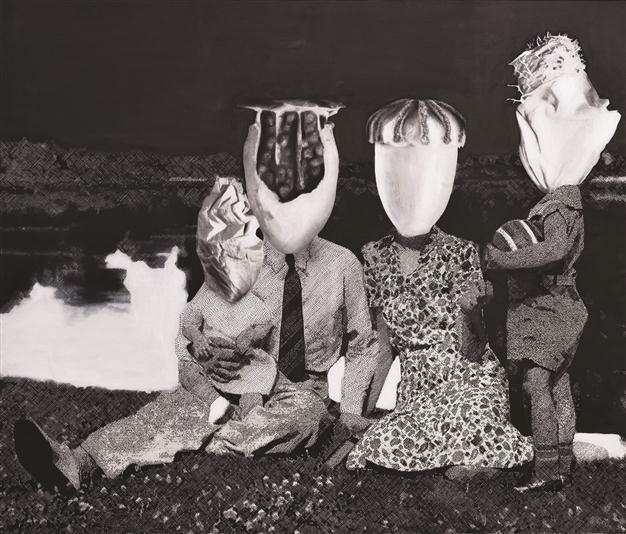Exhibition shows that criticism is ‘what I love’
ISTANBUL - Hürriyet Daily News

In September 1968 Marcel Broodthaers established the Musée d’
Art Moderne, Département des Aigles, which consisted of an installation of crates, postcards and inscriptions in his Brussels apartment. The museum was opened with an inaugural speech by Johannes Cladders, then director of the Museum in Mönchengladbach, Germany, which was followed by a discussion on the role of art within society.
In present-day terms, in
Turkey, while the country is going through a wild art market process with newly opening galleries and newly opened museums (both private and public), some exhibitions or some works act like “messages” sent to the future art society, hinting at the fate of works of art once they become a part of the art market.
The current exhibition at the Borusan Art Center, “What I Love,” may offer the best example of such messages. The exhibition brings together the latest works of 10 young artists, ranging from sculpture to video installation and including 3-D site-specific works.
By employing irony and avoiding dull expression, these works make reference to social phenomena observed in Turkey, as well as “offering differing perspectives on the oppressive art market,” said the curator of the exhibition, Dr. Necmi Sönmez.
The exhibition title hints at the topics that artists ponder during their stays at the Art Center, and the show attempts to preserve their individuality. The works criticize social life, the art market, artistic creation, daily life, museums, art galleries and much more.
While the Art Center did not interfere with the artists’ creations, Sönmez also did not lead the artists. During the creation process, the artists were totally free. The resulting works have the power to make the audience question the current situation of society.
İlke Yılmaz’s work, titled “Fishing,” focuses on the people of
Istanbul. “Locals of Istanbul who live near the sea have observed many changes during recent years,” she said.
Yılmaz aims to remind the audiences of the city’s past. The forests have been destroyed and the number of fishermen has increased due to the urbanization that has taken place. Many people fish to try to make money by selling their catch to cafes and restaurants. Indeed, those same fancy restaurants symbolize the huge gap between the rich and poor in Istanbul. Her sculpture depicts a woman who strikes the eye with her colorful clothes. It refers to the reality that locals live in their daily lives: what fisherman get from the sea is what they get in life.
Evrim Kavcar’s work also references the social life of Istanbul and Turkey. In one piece, Kavcar uses different disciplines, with sculpture (a dead mouse) combining with a video installation that points to some writing on the wall. With the life-sized mouse lying on the floor, Kavcar tries to make the audience realize it is a small animal, dead on the street. We don’t dare to touch it “because we get frightened that it could be carrying a virus or an illness,” she said. However, “it is not a filthy animal. It lives under the city and Istanbul is full of them. But it symbolizes something else.” Kavcar’s mouse may remind one of Dostoyevsky’s “Notes from the Underground.” Do the animals living underground resemble the people living on the ground?
Family life questionedHappy family portraits are shown as a deception in the works of Özge Enginöz. Enginöz adopts a unique collage technique to visualize the output of her works based on old family portraits. She does not draw straight lines between her topics of interest and neither do her figurative compositions; there is no negative or positive criticism in her work.
Berkay Tuncay, who recently joined the Art Center, is another artist dealing with family portraits, inspired by an accident that could happened to anyone. He takes photographs that are not fully revealed to show all the portraits and reveal “missing” parts of the photos.
Market is criticizedBurçak Konukman’s video work, which he also performs as himself, criticizes the art market. Konukman tries to reveal the hypocrisy of the art market as he is shown wearing shirts designed with “No Market Shit” written on them, before singing “The Internationale” with a gradually rising tone. Even though his work seems like the summary of a surrealist movie, Konukman unfolds the negative parts of becoming attached to the art market as an artist.
Elif Öner, on the other hand, criticizes the complex relationship in the museum collection with a web-based project she started last year. Her project, “Through the Looking Glass,” refers to the collections of museums and the situation of museums in modern life.
contemporary art,
 In September 1968 Marcel Broodthaers established the Musée d’Art Moderne, Département des Aigles, which consisted of an installation of crates, postcards and inscriptions in his Brussels apartment. The museum was opened with an inaugural speech by Johannes Cladders, then director of the Museum in Mönchengladbach, Germany, which was followed by a discussion on the role of art within society.
In September 1968 Marcel Broodthaers established the Musée d’Art Moderne, Département des Aigles, which consisted of an installation of crates, postcards and inscriptions in his Brussels apartment. The museum was opened with an inaugural speech by Johannes Cladders, then director of the Museum in Mönchengladbach, Germany, which was followed by a discussion on the role of art within society. 